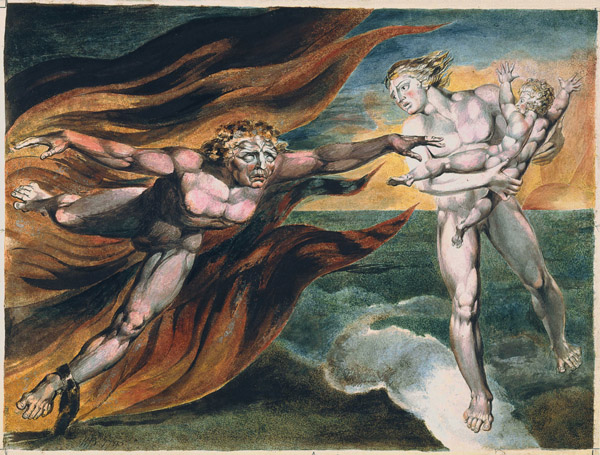Marriage of Heaven & Hell, Plate, (E 34)
"The voice of the Devil
All Bibles or sacred codes. have been the causes of the
following Errors.
1. That Man has two real existing principles Viz: a Body & a
Soul.
2. That Energy. calld Evil. is alone from the Body. & that
Reason. calld Good. is alone from the Soul.
3. That God will torment Man in Eternity for following his
Energies.
But the following Contraries to these are True
1 Man has no Body distinct from his Soul for that calld Body is
a portion of Soul discernd by the five Senses. the chief inlets
of Soul in this age
2. Energy is the only life and is from the Body and Reason is
the bound or outward circumference of Energy.
3 Energy is Eternal Delight"
Contraries
Body...............Soul
Energy...........Reason
Evil.................Good
Body...............Soul
Energy...........Reason
Evil.................Good
Blake used the same picture later as the basis for a watercolor painting and for an engraving reversing the positions of the figures. Here is the image from the Large Book of Designs.

If you are of the Devil's party the angel on the left is the good angel, if you favor conventional religion the angel on the right is the good angel. If you listen to Blake good and evil are contraries which can be resolved when they are seen in the light of Forgiveness and Brotherhood. Neither contrary is meant to claim possession of the child who represents their reconciliation. Each time Blake reproduced this image he modified it. In some the angel in flames is chained, in some he is blind. In some the angel in the light clings to the child, in some he releases it. In some the angels are both male, in some the sex is ambiguous. Blake found no way to present the tension between the contraries which encompassed all their dimensions. He gives us a variety of presentations so that we can resolve the tensions ourselves (and resolve the tensions within ourselves.)
Here are samples of comments on the picture.
Comment from the Tate Museum's Display Caption:
"In his annotations to a text by Lavater, Blake claimed that ‘Active Evil is better than Passive Good’, rendering the figures in this picture somewhat ambiguous. Perhaps the chain attached to the ‘evil’ angel’s ankle suggests the curtailing of energy by misguided rational thought?
In constructing his figures, Blake evokes conventional eighteenth century stereotypes. The heavy build and darker skin of the ‘evil’ angel suggest a non-European character, described by Lavater as ‘strong, muscular, agile; but dirty, indolent and trifling’, while the fair hair and light skin of the ‘good’ angel are consonant with ideas of physical – and intellectual – perfection."
From Inspiration of William Blake By Jah Wobble
"This painting conveys a strong sense of unreality, a form of artificiality reminiscent of simplistic childlike drama. William Blake informs me that there is a stage in the development of the human soul where we are handed over to the forces of darkness, often represented in his poetry by the state, church and family. This aspect can also be seen from the viewpoint of purely inner experience, dark primal instinct versus reason, the conscious versus the unconscious."
Terry Eagleton in The Guardian:
"Political states keep power by convincing us of our limitations.
They do so, too, by persuading us to be "moderate"; Blake, however, was not enamoured of the third way. The New Testament that Gordon Brown reads in his Presbyterian fashion as a model of prudence, conscience and sobriety, Blake read as a hymn to creative recklessness. He sees that Jesus's ethics are extravagant, hostile to the calculative spirit of the utilitarians. If they ask for your coat, give them your cloak; if they ask you to walk one mile, walk two. The road of excess leads to the palace of wisdom, and those who restrain their desires do so because their desires are feeble enough to be restrained."
June Singer in The Unholy Bible:
"The young child seen here is the newborn infant of Plate 3. He is Imagination, the treasured possession of the feminine spirit of energy. The anima, mistress of the soul, holds fast to her love-child, and keeps him out of reach of the masculine figure who represents Reason."
So, what does it mean to you?
2 comments:
The child has the face of the Prime Minister William Pitt. I think it is Jacob Bronowski who suggests this painting may be partly be read as a symbolised political comment. The figure on the left is an incarnation of Orc, the wild spirit of Jacobin rebellion (chained because the government has introduced repressive laws e.g. the Sedition Act).
I think that this post has been read more times than any other on this blog. Perhaps people hit on it looking for advice in a custody battle in a divorce case.
I appreciate your adding another perspective to those I cited. I see that the forces of conservative interests and of revolution in social, political, and economic conditions tore at Pitt who was trying to govern in turbulent times.
The quote from Harold Bloom which I included in my last post may be apropos for this image too:
"But in the 1818 fragment the drama remains the static threefold scene: Christ and Lucifer arguing their opposite views before "Me" (Every man, or Joseph of Arimathea, or Blake)."
Thanks for your comment opening the possibility of viewing the image as "symbolized political comment" on situations through which Blake was living.
ellie
Post a Comment